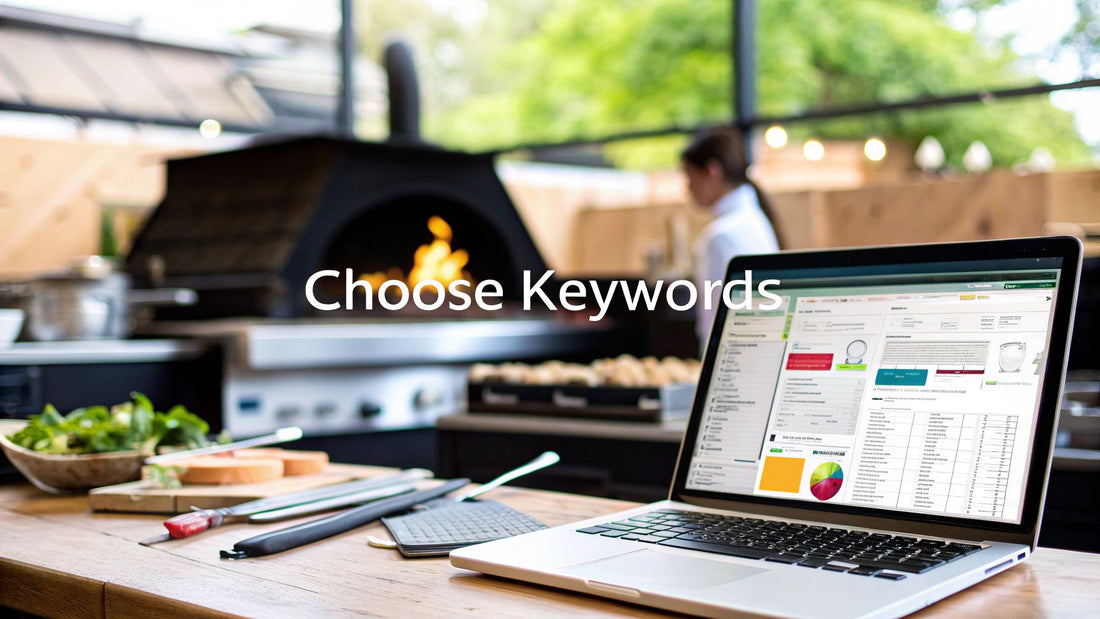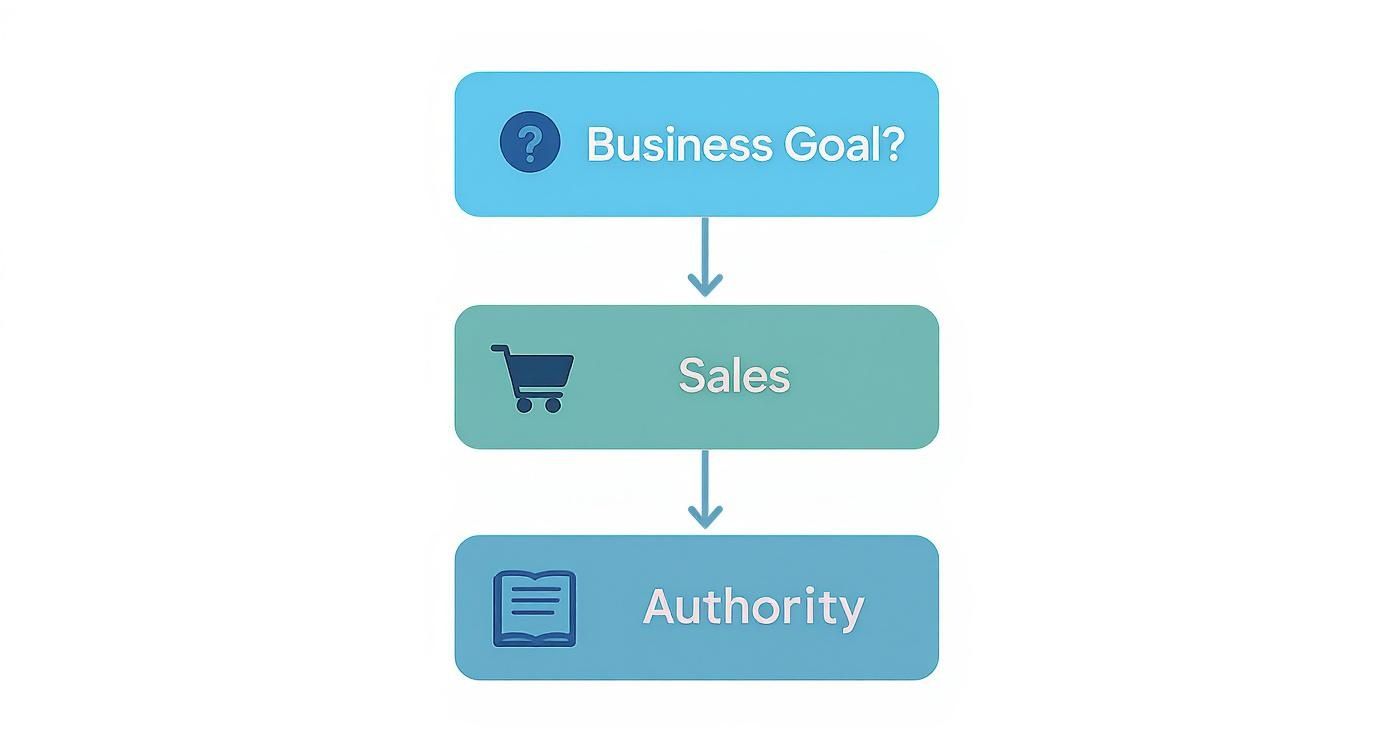
How to Choose Keywords for Your Restaurant Equipment Supply Site
Share
Choosing the right keywords isn't about what you think people are typing. It's about knowing who is doing the searching in the first place. A winning keyword strategy always starts by connecting your business goals—like selling more charbroilers—to the real-world problems your customers have, using their own language.
Build Your Keyword Strategy on a Solid Foundation
The biggest mistake we see restaurant equipment suppliers make is jumping straight into a keyword tool. That's putting the cart before the horse. The most important work happens long before you analyze a single search term. It’s about getting inside the heads of the people you’re trying to reach.
Think about it: a busy restaurant owner, a meticulous head chef, and a budget-conscious procurement manager are all looking for different things. Each one has unique needs, specific pain points, and a completely different way of searching for a solution.
Good keyword research is built on simple but solid customer profiles. These profiles help you pinpoint the real problems your audience is dealing with every day. For a head chef, the main concern might be consistent cooking and how much grill space they have. A procurement manager, on the other hand, is probably worried about energy efficiency and long-term maintenance costs.
Connect Keywords to Business Goals
Every single keyword you target needs to tie back to a business objective. What are you trying to accomplish? Sell more commercial deep fryers? Generate leads with valuable blog content? Become the number one resource for kitchen efficiency? Our SEO and article writing services help you figure that out first, making your whole approach clearer.
For example, just look at the difference between these two searches:
- 'Commercial oven repair': This person has an urgent, immediate problem. They're likely a current owner in a panic, and they need a fast solution. Any content you create for this keyword has to be service-based and focused on solving their issue now.
- 'Best convection ovens for bakeries': This searcher is in the research phase, getting ready to make a purchase. They need comparisons, reviews, and detailed specs. Your content here should be educational and persuasive, guiding them toward a decision.
Getting a handle on this difference in search intent is absolutely crucial. It stops you from wasting time and money creating content that doesn't match what the searcher actually needs.
A strong keyword foundation isn't about digging up obscure terms. It’s about aligning what you know with your customer's journey. Once you understand their problems, you can predict the exact words they'll use to solve them.
Think Globally and Act Locally
This customer-first mindset goes beyond just technical jargon. In today’s connected market, you have to consider how language and culture impact keyword research. By 2025, it's estimated that 70% of all global search queries will be in languages other than English.
It’s a huge opportunity. Websites that localize their SEO can see a 70% jump in organic traffic within a year simply because most people would rather buy something in their native language. Properly adapting your content for different regions is more than just a direct translation—it can completely change your results. You can find more great insights on international SEO over at SearchAtlas.
At the end of the day, a solid keyword strategy starts with knowing where your website currently stands. Running an audit can uncover foundational problems and hidden opportunities you’d otherwise miss. Before you go any further, check out our guide on how to perform a website audit to make sure you're building on solid ground.
Translate Search Intent Into Sales
Knowing what a potential customer types into Google is a good start, but it's only half the story. The real breakthrough comes when you figure out why they searched for it. This "why" is what we call search intent, and it’s the secret sauce for turning website visitors into paying customers for your restaurant equipment business.
Every single search query fits into one of four main categories. Once you get a handle on these, you can create the exact type of content that speaks to customers at every stage of their buying journey. Our copywriting and blog posting services ensure you're not wasting time writing a blog post for someone who’s ready to buy, or pushing a product page on someone who’s just starting their research.
Think of it like this: your business goals should be the foundation for every keyword you target.

As you can see, whether you're chasing direct sales or trying to build your brand's authority, it all starts with a clear objective. That objective then tells you exactly which keywords to go after.
The Four Flavors of Search Intent
Let’s dig into the four main types of search intent, using real-world examples you'd actually see in the restaurant supply space.
-
Informational Intent: This is your classic "I need to know something" search. The user has a problem or a question, and they're looking for answers. Think of a head chef Googling things like "how to clean a charbroiler" or "what is the best temperature for searing steak." They aren't pulling out their credit card yet; they just need solid information.
-
Navigational Intent: The user already knows where they want to go and is just using Google as a shortcut. Searches like "Garland charbroilers official site" or "your company's login page" fall squarely into this category. They’re looking for a specific destination, not options.
-
Commercial Intent: Here, the user is definitely in the market for a charbroiler but is still kicking the tires and comparing their options. Their keywords often include modifiers like "best," "review," or "vs." A restaurant manager searching for "best 36 inch gas charbroiler reviews" or "Radiant vs lava rock charbroiler" is a perfect example.
-
Transactional Intent: This is the money-maker. The user is ready to buy, right now. Their search terms are direct, specific, and full of action words like "buy," "price," "for sale," or even a specific model number. When you see a search for "buy Garland G24-4B charbroiler," that’s a customer with their wallet out.
Understanding these differences is absolutely fundamental. If you try to rank for a transactional keyword like "buy commercial charbroiler" with a long, informational blog post, you've missed the mark. The user will hit the back button in seconds because your content doesn't match their urgent need.
Mapping Intent to Your Content
To really nail your SEO, you have to align your content with the right search intent. It's not optional. This is how you attract the right people at the exact moment they're ready to hear what you have to say.
The table below breaks down how to think about this for a restaurant supply business.
Mapping Search Intent to Restaurant Supply Keywords
| Search Intent Type | User Goal | Example Keyword | Ideal Content Type |
|---|---|---|---|
| Informational | Learn something or solve a problem. | "how to season a new charbroiler" | Blog Posts, How-To Guides, Videos |
| Navigational | Find a specific brand or website. | "Vulcan equipment login" | Homepage, About Us Page, Contact Page |
| Commercial | Compare products and find the best option. | "best countertop charbroiler 2024" | Product Comparison Guides, "Best Of" Lists |
| Transactional | Make a purchase now. | "36 inch charbroiler for sale" | Product Pages, Category Pages, E-commerce |
This table shows a clear path from the user's goal to the content you need to create. Matching them up is how you win.
Here's how you put that into practice:
-
For Informational Searches: Write genuinely helpful, in-depth blog posts. A search for "how to clean cast iron grates" deserves a step-by-step guide with pictures or a video that actually solves the problem, subtly positioning your brand as the expert.
-
For Commercial Searches: Create detailed product comparisons and "best of" listicles. Someone searching for "top rated countertop charbroilers" is looking for an article that breaks down the top three models, complete with pros, cons, and specs. Give them that, and you'll earn their trust.
-
For Transactional Searches: This is where you double down on optimizing your product and category pages. These pages need crystal-clear pricing, high-quality photos from every angle, detailed specifications, and a big, obvious "Add to Cart" button. Make it effortless for them to buy. This is where your hard work on keywords like "36 inch charbroiler for sale" directly translates into revenue.
How to Find and Analyze Your Core Keywords
Alright, you've got a good handle on your customer and what they’re searching for. Now it’s time to roll up our sleeves and get into the nitty-gritty. The goal here is to move from those big, general ideas to a concrete list of keywords you can actually put to work. This all starts with what we call "seed" keywords.
Think of seed keywords as the foundational terms that describe your business at its core. For a restaurant equipment supplier, these are the big-picture terms like "commercial kitchen equipment" or "restaurant refrigeration." They're the starting points on a much larger map. Sure, they're often broad and super competitive, but they’re the bedrock from which all your other keyword opportunities will sprout.

From these seeds, we’ll use specialized tools to unearth related terms, questions, and specific phrases your customers are plugging into Google every day. This is where platforms like Ahrefs, Semrush, or even the free Google Keyword Planner become your best friends. Pop in your seed keywords, and you can uncover thousands of related queries you'd probably never think of on your own. For a deeper dive into this foundational process, check out this comprehensive guide on how to choose keywords for SEO.
Decoding the Metrics That Matter
As you start digging, you're going to be hit with a flood of data. It’s easy to get lost in the numbers, but you really only need to focus on a few key metrics to make smart calls. Let's break down what they actually mean for your business.
-
Search Volume: This is simply the average number of times a keyword gets searched for each month. A huge volume might look tempting, but it almost always comes with brutal competition. A term like "commercial oven" will have massive search volume, but trying to rank for it is a monumental task for most businesses.
-
Keyword Difficulty (KD): Usually scored from 0-100, this metric gives you a rough idea of how hard it'll be to crack the first page of Google. A lower KD score means less competition, which points to a more realistic opportunity, especially for newer or smaller websites.
-
Cost Per Click (CPC): This shows how much advertisers are willing to pay for a single click from a specific keyword. A high CPC is a dead giveaway for strong commercial intent. It’s a blinking neon sign that tells you the people searching this term are ready to buy.
Your goal isn't just to find high-volume keywords. The real sweet spot is a balanced list that includes some of those high-traffic "reach" terms alongside lower-competition, high-intent keywords you can realistically rank for—the ones that will actually drive sales.
Building Your Master Keyword List
The sheer scale of search activity is why this process is so important. By 2025, Google is expected to field over 99,000 search queries every single second. And with Google owning over 90% of the global search market, getting this right is non-negotiable. It’s also interesting that in the U.S., more than 80% of searches are between one and three words long, which shows that those core, high-volume terms still have plenty of power.
As you gather your keywords, get them organized in a spreadsheet. This master list becomes your single source of truth, letting you sort, filter, and prioritize with a clear head. By the end of this stage, you won’t just have a pile of data; you'll have a practical workflow that turns raw numbers into a strategic keyword plan, perfectly balancing broad opportunities with the targeted terms that actually convert.
Uncovering Niche and Long-Tail Keyword Opportunities
While your competitors are locked in an expensive battle over broad, high-traffic terms like "charbroiler," the real money is often made in the margins. This is where long-tail keywords come into play—those super-specific, multi-word phrases that reveal exactly what a potential customer is looking for.
Think about the difference. A search for "charbroiler" is a shot in the dark. But when someone searches for "best countertop gas charbroiler for small cafe," you know everything. They have a specific product type, power source, and size constraint in mind for a clear commercial application. This isn't just a browser; this is a buyer.

These highly specific keywords naturally have much less competition. That gives you a realistic shot at landing on the first page of Google and pulling in traffic that’s actually ready to convert.
Finding Your Hidden Gems
So, where do you dig up these valuable long-tail phrases? They’re usually hiding in plain sight, right where your customers are asking questions and searching for solutions. We always start by looking in these key areas:
- Google's 'People Also Ask' Section: Type a broad term like "commercial griddle" into Google and just scroll down. This section is a goldmine of question-based keywords that show you the exact problems your audience is trying to solve.
- Industry Forums and Social Media: Keep an eye on restaurant and chef communities on platforms like Reddit or LinkedIn. The discussions happening there are filled with the natural language your customers use, revealing pain points and specific product needs.
- Your Own Customer Service Data: What questions do your sales and support teams hear every single day? Your own customer interactions are an untapped source of long-tail keywords based on real-world challenges.
Targeting long-tail keywords isn't just an SEO tactic; it's a customer research strategy. It forces you to listen to what your audience truly needs, allowing you to create content that solves their specific problems and builds lasting trust.
Answering Questions to Build Authority
Another powerful approach is to target question-based keywords directly. Phrases like "how to season a new commercial griddle" or "what's the difference between lava rock and radiant charbroilers?" are perfect fuel for your blog. Our article writing and blogger outreach services specialize in this.
This strategy does more than just attract traffic. It positions your brand as an industry authority. When a restaurant owner finds a genuinely helpful article on your site that solves their immediate problem, you're no longer just another supplier—you're a trusted resource they'll come back to.
While broad terms have their place, the data shows where the real action is. Long-tail keywords—those with three or more words—account for a surprising 70% of all search traffic. These longer queries show more specific intent and face way less competition. To truly uncover these niche opportunities, you need dedicated long-tail keyword research techniques. It makes sense when you see that the average search query in the U.S. is now 3.4 words long; people are getting more detailed and you need to be there to meet them.
Weaving Keywords into Your Content Strategy
https://www.youtube.com/embed/IrFAeQgzE7w
Having a perfectly researched keyword list is a great starting point, but it's just that—a start. That list is basically useless until you actually put it to work. The real magic happens when you start weaving those terms into your website’s content in a way that feels completely natural to a reader but also signals all the right things to search engines.
This is the heart and soul of on-page SEO.
Your goal isn’t to create robotic-sounding pages stuffed with keywords. It's to build user-first content that search engines can't help but love. When you get this right, your keyword research translates directly into better rankings and more visibility for your charbroilers and other restaurant equipment.
Optimizing Your On-Page Elements
Think of your keywords as guideposts for both your customers and the search engine crawlers that visit your site. Placing them in a few key locations helps clarify exactly what each page is about, making sure you attract the right kind of traffic.
Here are the most critical spots to place your primary keywords:
- Page Title (Title Tag): This is the single most important piece of real estate. Try to get your main keyword as close to the beginning of the title as you can for maximum impact.
- Meta Description: While it's not a direct ranking factor, a well-written meta description that includes your keyword is your sales pitch on the search results page. It's what convinces someone to click on your link instead of a competitor's.
- Headings (H1, H2, etc.): Your main heading (the H1) absolutely has to include your primary keyword. From there, use variations and related terms in your subheadings (H2s, H3s) to build out the context of the page.
- Image Alt Text: This is simple but so often overlooked. Describe your images accurately for visually impaired users and slip in a relevant keyword while you're at it. For a charbroiler photo, something like, "Front view of a 36-inch countertop gas charbroiler" is perfect.
The name of the game is relevance, not repetition. We want to avoid "keyword stuffing"—that old-school, ineffective tactic of just jamming a keyword into a page over and over. A good rule of thumb is to focus on one primary keyword and a handful of secondary variations per page. For a much deeper look at this, our article on how many keywords to target per page breaks it all down.
A Practical Checklist for Every Page
To keep things consistent, it helps to have a simple checklist. Every time you create a new product page for a piece of equipment or write a blog post for your website, just run through these quick checks.
This process is critical because the competition online is absolutely fierce. The data doesn't lie: about 75% of users never click past the first page of search results. Even more telling, 70% of all clicks go to just the top five organic listings.
It's a winner-take-all environment out there. This dynamic makes precise, thoughtful keyword targeting essential for driving traffic that actually turns into sales. You can dig into more powerful SEO stats like these from our friends over at Keyword.com. By carefully integrating your keywords, you give your content the best possible chance to rank where it really matters—on page one.
Answering Your Top Keyword Research Questions
Even with the best plan, you're bound to run into a few tricky spots during keyword research. It happens to everyone. Think of this section as a quick-reference guide to help you navigate those common hurdles and make decisions with confidence.
Let's dive into some of the questions that come up most often.
How Often Should I Be Updating My Keywords?
This is a big one. It's a classic mistake to treat keyword research as a one-and-done project. You create a list, tuck it away, and never look at it again. But your keyword strategy needs to be a living, breathing part of your marketing. Markets shift, customers start searching in new ways, and competitors are always trying to get an edge.
As a general rule, you should do a deep-dive review of your entire keyword strategy at least once a year. But you can't just set it and forget it until then.
- Quarterly Check-ins: Every three months is a perfect time to see what’s working. Take a look at your top-performing keywords and see if any are starting to slip. It's also a great opportunity to spot new trends or questions popping up in your industry.
- Ongoing Monitoring: You need to keep a regular pulse on your keyword rankings. A sudden drop can be a red flag—maybe a Google algorithm update just rolled out, or a competitor is making a big push. Catching it early means you can react quickly.
The bottom line is that keyword research isn't a static task; it’s a continuous process. Regularly revisiting and refining your keywords is the only way to keep your content relevant and make sure you’re consistently attracting the right audience for your charbroilers.
Should I Focus on Local or National Keywords?
For a restaurant equipment supplier, the honest answer is almost always "both." They just serve completely different purposes, so you need to approach them with different goals in mind.
- National Keywords: Go broad with your blog content. Think about informational topics that attract restaurant pros from all over the country, like "how to clean commercial charbroiler grates." This kind of content doesn't sell a product directly, but it builds your authority and brings a wide audience to your site.
- Local Keywords: When you want to make a sale or book a service call, you have to get local. This is where you target those high-intent phrases like "restaurant equipment repair in [Your City]" or "buy commercial charbroiler near me." Our local citation services are designed to help you dominate these searches.
The key is matching the keyword's scope to what the searcher actually wants and what your business can realistically provide.
What If My Target Keywords Are Too Competitive?
You're going to run into keywords that are incredibly tough to rank for. It's just a fact of life, especially for broad terms like "commercial ovens." Trying to outrank the established giants on these terms can feel like an expensive, uphill battle you’re not likely to win.
So, don't play their game. Pivot.
Instead of fighting for the top spot on a super-competitive term, focus on long-tail keywords where you can carve out your own space. Rather than just "commercial ovens," get specific and target "best countertop convection oven for small bakery" or "energy-efficient combi oven reviews."
Yes, these terms have lower search volume, but the audience is so much more qualified and closer to making a purchase. You can get a much clearer picture of your performance by learning how to track keyword rankings for these highly specific phrases. This is how you find and completely own valuable, less-contested corners of the market.
Ready to turn your keyword research into more sales? The team at Charbroilers.com specializes in creating perfectly seasoned content that attracts chefs and restaurant owners. Explore our high-performance commercial charbroilers today!
